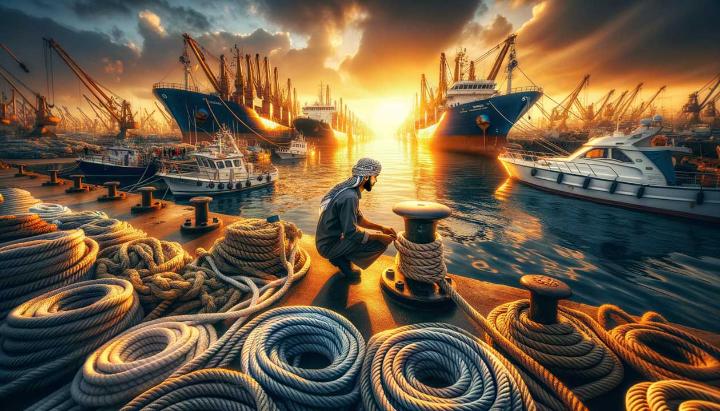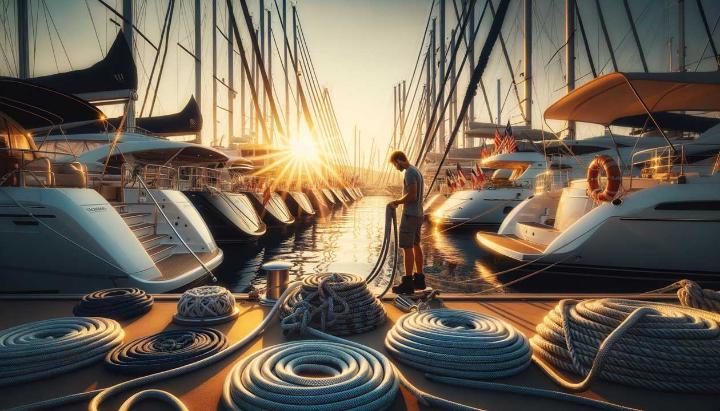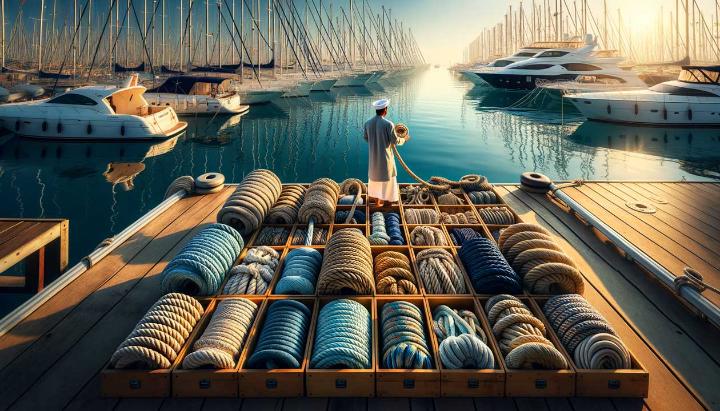Have you ever wondered why a tiny yacht and a massive cargo ship use vastly different mooring ropes? It's not just about size—it's a matter of science, safety, and seamanship. From the sleek lines of a luxury yacht to the towering hull of an ocean-going vessel, each requires a unique approach to secure mooring.
In this essential guide, we'll navigate the complex world of mooring ropes for ships and yachts, exploring everything from the lightweight yet sturdy ropes that keep your weekend cruiser safely docked to the large mooring ropes that withstand the immense forces exerted on commercial vessels. Whether you're in the market for yacht ropes for sale or simply curious about the engineering behind maritime safety, this post will equip you with the knowledge to make informed decisions.
Join us as we unravel the intricacies of mooring rope selection, from materials and sizes to crucial factors like breaking strength and environmental resistance. By the end of this journey, you'll understand why choosing the right mooring rope is not just a purchase—it's an investment in your vessel's security and your peace of mind on the water.
Types of Mooring Ropes for Ships
When it comes to securing vessels, from nimble yachts to massive cargo ships, choosing the right mooring ropes is crucial. Let's dive into the world of mooring ropes and explore the various types that keep our vessels safely tethered.
Common Materials Used in Mooring Ropes
As a seasoned sailor, I've had my fair share of experiences with different mooring ropes. Trust me, the material makes all the difference when you're battling choppy waters or fierce winds. Here's a breakdown of the most common materials you'll encounter:
- Synthetic ropes: These modern marvels have revolutionized the maritime industry. Nylon, polyester, and polypropylene are the go-to choices for many vessels.
- Natural fibre ropes: While less common nowadays, traditional materials like manila, hemp, and sisal still have their place in certain applications.
- Wire ropes: For heavy-duty tasks, especially on larger ships, wire ropes offer unparalleled strength and durability.

Function and Importance of Mooring Lines
Have you ever wondered why ships use different types of mooring lines? It's not just about tying the ship to the dock. Each line plays a crucial role in keeping the vessel stable and secure:
- Bowlines: These front lines prevent the ship from drifting away from the pier.
- Stern lines: Positioned at the rear, they keep the ship's back end in place.
- Spring lines: Running diagonally, these lines prevent the ship from moving forward or backward.
Choosing the right mooring ropes isn't just about strength; it's about finding the perfect balance of durability, flexibility, and resistance to environmental factors. UV resistance and abrasion resistance are crucial properties that can make or break a mooring system.
Remember, the size of your vessel plays a significant role in determining the appropriate mooring ropes. A small yacht might do well with a 12mm synthetic rope, while a large cargo ship could require massive 80mm wire ropes. It's all about matching the rope to the job at hand.
Did you know? UHMWPE (Ultra-High-Molecular-Weight Polyethylene) ropes are gaining popularity for their incredible strength-to-weight ratio and resistance to UV damage.
As we navigate through the complexities of mooring ropes, it's clear that selecting the right type is crucial for the safety and efficiency of any maritime operation. Whether you're outfitting a small pleasure craft or a massive container ship, understanding these rope types will help you make an informed decision.
Key Factors in Selecting Large Mooring Ropes
Choosing the right mooring ropes for your vessel is a crucial decision that can impact safety, performance, and longevity. As a seasoned mariner, I've learned that selecting large mooring ropes requires careful consideration of several key factors. Let's dive into the essential elements you need to keep in mind when making this important choice.
Material and Strength Considerations
When it comes to large mooring ropes, strength is paramount. The material you choose plays a significant role in determining the rope's breaking strength and overall performance. In my years at sea, I've worked with various materials, each with its own unique properties:
- Nylon: Excellent elasticity and strength, ideal for absorbing shock loads.
- Polyester: Low stretch and high UV resistance, perfect for static mooring situations.
- HMPE (High-Modulus Polyethylene): Incredibly strong for its weight, with superior abrasion resistance.
Remember, the breaking strength of your mooring rope should be significantly higher than the anticipated loads. A good rule of thumb is to apply a safety factor of 6 to 10 times the expected maximum load.
Pro tip: Always check the manufacturer's specifications for breaking strength and work within the recommended safety factors to ensure your vessel's security.
Diameter and Length Requirements
The size of your vessel directly influences the diameter and length of the mooring ropes you'll need. As a general guide:
- Small yachts (up to 30 feet): 12-16mm diameter ropes, typically 15-20 meters long.
- Medium-sized vessels (30-60 feet): 18-24mm diameter ropes, around 25-30 meters in length.
- Large ships (60+ feet): 24mm+ diameter ropes, with lengths often exceeding 50 meters.
Remember, these are general guidelines. Always consult your vessel's specifications and local port requirements for the most accurate recommendations.
Environmental Factors and Durability
The marine environment can be harsh on mooring ropes. UV exposure, saltwater, and extreme temperatures can all take their toll. In my experience, considering these factors is crucial for maximizing the lifespan of your ropes:
- UV resistance: Opt for ropes with built-in UV inhibitors, especially if your vessel is frequently moored in sunny locations.
- Chemical resistance: Choose materials that can withstand exposure to saltwater and potential oil or fuel spills.
- Temperature range: Ensure your ropes can perform well in both hot and cold climates if you plan on sailing in diverse regions.
Regular inspections and proper maintenance are key to extending the life of your mooring ropes. I make it a habit to check my ropes for signs of wear, clean them periodically, and store them properly when not in use. You can also explore different types of [high-strength mooring ropes solutions](https://www.iropes.com/blog/insights-4/discover-the-best-synthetic-winch-line-for-high-performance-106) to ensure optimal performance.
By carefully considering these factors - material strength, size requirements, and environmental durability - you'll be well-equipped to select the perfect large mooring ropes for your vessel. Remember, investing in high-quality ropes is an investment in your safety and peace of mind on the water.
Choosing the Right Yacht Ropes for Sale
As an experienced sailor, I've learned that selecting the perfect yacht ropes is as crucial as choosing the right sails. It's not just about picking any old rope; it's about finding the ideal balance between strength, durability, and performance for your specific vessel. Let's dive into the world of yacht ropes and discover how to make the best choice for your nautical adventures.
Understanding Yacht Rope Types and Materials
When I first started sailing, the variety of rope options overwhelmed me. Now, I can confidently guide you through the maze of materials and constructions. Here's a quick rundown of the most common yacht rope types:
- Nylon: Excellent for anchor and mooring lines due to its stretch and shock absorption.
- Polyester: Ideal for running rigging, offering low stretch and high UV resistance.
- Dyneema/Spectra: Ultra-strong and lightweight, perfect for halyards and sheets on performance yachts.

Remember, the construction of the rope matters too. Braided ropes offer better handling and durability, while twisted ropes are more affordable and easier to splice. Your choice depends on the specific application and your budget.
Factors to Consider When Selecting Yacht Ropes
Now, let's talk about sizing. A rule of thumb I always follow is the 1/8" diameter per 9 feet of boat length for dock lines. But don't just take my word for it; always consult your boat's manual or a professional rigger for precise recommendations. For example, some sailors prefer [yacht ropes with specific types of nylon materials](https://www.iropes.com/blog/insights-4/discover-the-best-nylon-yacht-rope-116).
Here are some key factors to keep in mind:
- UV resistance: Crucial for ropes exposed to constant sunlight.
- Stretch properties: Important for shock absorption in mooring lines.
- Breaking strength: Ensure it exceeds your boat's requirements by a safe margin.
- Handling characteristics: Consider how the rope feels in your hands, especially for frequently adjusted lines.
Don't forget about color! While it might seem purely aesthetic, bright colors can enhance visibility and safety, especially for mooring lines.
Pro tip: Invest in high-quality ropes for critical applications like anchor lines and sheets. The peace of mind and longevity are worth the extra cost.
When it comes to budget, remember that cheaper isn't always better. I've learned the hard way that investing in quality ropes can save you money in the long run. They last longer, perform better, and provide greater safety. However, you don't need top-of-the-line ropes for every application. Balance your needs with your budget for the best results. Additionally, it's beneficial to explore [top-quality yacht rope suppliers](https://www.iropes.com/blog/insights-4/discover-the-best-yachting-rope-suppliers-today-306) to find reliable options.
By considering these factors and understanding the different types of yacht ropes available, you'll be well-equipped to make an informed decision. Remember, the right ropes not only enhance your sailing experience but also contribute significantly to your safety on the water. Happy sailing!
Essential Practices for Mooring Rope Maintenance
As a seasoned mariner, I can't stress enough the importance of proper mooring rope maintenance. These vital lines are the unsung heroes of our maritime adventures, keeping our vessels secure in all conditions. Let's dive into the essential practices that will ensure your mooring ropes remain in top-notch condition, ready to weather any storm.
Proper Cleaning and Storage Techniques
Maintaining your mooring ropes starts with proper cleaning. After a long voyage, I always make sure to give my ropes a thorough wash. Here's my tried-and-true method:
- Rinse thoroughly: Begin by rinsing the ropes with fresh water to remove salt, sand, and debris.
- Gentle cleaning: Use a mild soap solution and a soft brush to clean the ropes gently.
- Rinse again: Give the ropes a final rinse to remove all soap residue.
- Air dry: Allow the ropes to dry completely in a well-ventilated area, away from direct sunlight.
Once clean and dry, proper storage is crucial. I've learned the hard way that improper storage can significantly shorten a rope's lifespan. Here's what I recommend:
- Cool and dry: Store ropes in a cool, dry place to prevent mold and mildew growth.
- Avoid direct sunlight: UV rays can weaken synthetic fibers, so keep ropes out of direct sunlight when not in use.
- Coil properly: Use a figure-eight coil to prevent twists and kinks.
- Elevate: Store ropes off the ground to avoid moisture absorption and potential chemical exposure.
Pro tip: Never store wet ropes in enclosed spaces or plastic bags, as this can lead to mildew and rope degradation.
Preventing Wear and Damage to Mooring Ropes
Prevention is always better than cure when it comes to mooring rope care. Here are some practices I swear by to minimize wear and tear:
- Use chafing gear: Apply chafing protection at contact points to prevent abrasion.
- Proper handling: Avoid dragging ropes across rough surfaces or sharp edges during mooring operations.
- Regular inspections: Check your ropes frequently for signs of wear, cuts, or internal damage.
- Rotate usage: Alternate the use of your mooring lines to distribute wear evenly.
For wire ropes, don't forget the importance of lubrication. A well-lubricated wire rope is less susceptible to internal corrosion and wear. Apply a marine-grade lubricant regularly, ensuring it penetrates the core of the rope.
Lastly, knowing when to replace your mooring ropes is crucial for safety. During your regular inspections, look out for these warning signs:
- Visible wear: Fraying, cuts, or abrasions on the outer layer.
- Discoloration: This could indicate chemical damage or UV degradation.
- Stiffness: Loss of flexibility can mean internal damage.
- Flat spots: These indicate structural damage to the rope's core.
Remember, when in doubt, it's always better to replace a rope than to risk your vessel's safety. By following these maintenance practices, you'll not only extend the life of your mooring ropes but also ensure the safety of your crew and vessel. Happy sailing, and may your moorings always hold fast!

Ready for Custom Mooring Ropes?
Selecting the right mooring ropes for ships and yachts is vital for safety and performance. From synthetic ropes like nylon and polyester to natural fibres and strong wire ropes, the options vary in strength and durability. For large ships, factor in load capacity, environmental conditions, and abrasion resistance. Meanwhile, yacht ropes for sale require careful consideration of diameter, length, and visibility. Proper maintenance extends the lifespan of mooring ropes, ensuring reliable performance. Explore our custom solutions to find the perfect fit for your vessel. Fill out the form above to discover more about our tailored offerings.